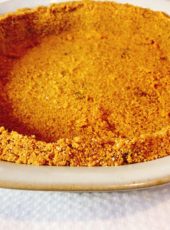From a cracker made to suppress sin, to a crust for the Jazz Age, this American standard is elevated by browned butter and salt – it’s sinful!
“Please google why graham crackers were invented.” – Twitter and Tik Tok, 2021
The bizarre answer is that the original crackers were created by Sylvester Graham, an evangelical minister involved in temperance movements of the 1830’s, to subdue Americans’ sinful interest in sex. He believed that fattening, meaty, flavorful foods – the canonical American diet – aroused the body the way it aroused the senses. American excess – in sex, gluttony, and consumerism – was slowly killing us.
While he believed he was fighting core American exploits, he was invested in another: the rejection of the land of plenty in favor of puritanical rigidity and self-deprivation. As American as excess is, puritanical diatribes against it have become part of our fabric too. Today dietary purism rivals the pursuit of spiritual purism. In a society that is mostly religiously tolerant and mostly secular, other identity markers have emerged to evaluate the most pious among us. This is at least one of the many and complicated reasons behind America’s diet culture. And Graham was an early diet guru, of which many more would come. His perspective fit in with the times. According to Samuel Magida, writing for NYU’s Confluence, Graham theory was part of The Popular Health Movement of the time, which merged perfectly with premises of Jacksonian democracy. A newly articulated idea had emerged in American popular culture: to be a healthy democracy, we needed to be a fit citizenry; implicit in this was that each citizen had a moral responsibility to fulfill their part of the bargain.

The Graham Diet proselytized the value of a bland diet, heavy on whole grains, fruits, and vegetables while avoiding meat, alcohol, and spices; it dictated that portions should be small and there should only be two meals per day. According to Adee Braun, writing for The Atlantic, like other fad diets to follow, this diet craze had ardent followers: Grahamites. Several male-only boarding houses emerged that followed his prescription for diet, exercise, sleeping, and bathing regimens. Oberlin College adopted The Graham Diet for their dining plan in 1838. It was only rescinded when students protested a professor being fired for using black pepper on his meal! If it sounds stricter than keto to you, I believe you’d be right. Grahamites testified to the physical and mental benefits of their deprivation; and they avidly believed that food and sex were complimentary evils. Braun quotes Jayme Sokolow in Eros and Modernization: Sylvester Graham, Health Reform, and the Origins of Victorian Sexuality in America, “both drives represented dangers to complete self-control and independence.”
Then, as now, a suggestion to change ingrained behaviors met with angry backlash. Butchers and bakers mobbed his speaking events, threatening violence. He was also mobbed by a group of women for attempting to lecture them on the virtues of chastity.
Graham was a nut and zealot, and he didn’t sound like he’d be very much fun at parties. But, like a lot of nuts, he got some things right. Not everything about his diet was a bad idea. I recommend spices, but plant-based options are surely a healthful idea. Vegetarians might be interested to know that he’s considered one of the fathers of the vegetarian movement in the United States. And to offer a very specific example of his more noble crusade, he was critical of shortcuts in the bread making process and was especially angry about the use of white flour instead of whole wheat. This is why he developed his own process for making whole wheat flour, which he called Graham bread. Food Republic reports that it wasn’t until 1925 that the graham crackers we know today began being massed produced. That’s when the company that would eventually become Nabisco advertised them under the name “sugar honey grahams.”
Even more adaptation was soon to follow in the form of a new American culinary invention – graham cracker pie crust. Atlas Obscura shares that this was likely introduced around 1926, the height of the Jazz Age. Monroe Boston Strause, known as the Pie King of LA, invented it to compliment his other new invention: the chiffon pie; the light buttery crunch balanced the ethereal nature of the chiffon filling. Strause emphasized the scientific nature of baking, referring to his recipes as “formulas” and inferring that housewives were too “slipshod,” or undisciplined or hairbrained, to effectively bake. I don’t love that last part. It reeks of a familiar stink in the culinary world – until recently only women were the everyday cooks for their families while only men could accrue wealth and fame as chefs. However, the graham cracker crust was genius. He deserves his title, and the “bank president’s salary” he earned along with his fame.
I first learned about browning butter for desserts from Smitten Kitchen’s recipe for Salted Brown Butter Crispy Treats. They are truly divine. You should make them. I applied the same logic here, now I always salt and brown the butter for my graham cracker crust. It’s divine. You should make it.
Salted Browned Butter Graham Cracker Crust
Recipe by MauraCourse: DessertDifficulty: Easy8-12
servings20
minutes10
minutesIngredients
1 & 1/2 cups crushed graham cracker crumbs (see note 1)
3 TBSP brown sugar
1 tsp coarse sea salt
10 TBSP butter, browned
Directions
- Crush your graham crackers either by using a food processor (that's what I do) or placing crackers in a ziplock bag and crushing them with a rolling pin. A food processor will ensure finer crumbs.
- Mix in brown sugar and salt; set aside
- Brown your butter by placing them in a pot over medium heat on the stove. You should use a rubber spatula to mix occasionally. After the butter is melted, the next stage toward browned butter is the foaming stage - you will hear sizzling and the butter will briskly foam. Keep mixing. Soon the bubbles will begin to subside and as you mix you'll see an amber color underneath. You will smell a deep, rich, nutty aroma come from the pot. This will happen 5-8 minutes after you started the process. Toward the end you want to watch the pot carefully and move quickly - your butter can go from browned to burnt quickly!
- Mix the browned butter in with the graham cracker mix, wetting all the crumbs.
- Use a measuring cup to evenly press the crumbs across the bottom of a 9" or 10" pie tin, and up its sides. (A smaller tin will mean a thicker crust.)
- Bake for 10 minutes at 350F to set the crust.
Notes
- In a "fresh stacks" box of graham crackers wrapped squares (not rectangles), about 3 packages, or half the box of 6, will be about 1.5 cups when crushed.





